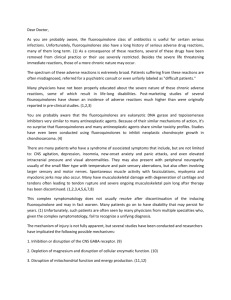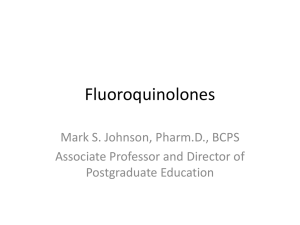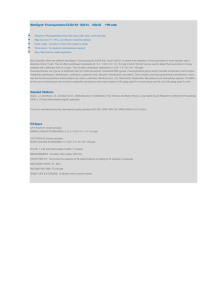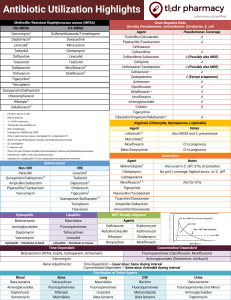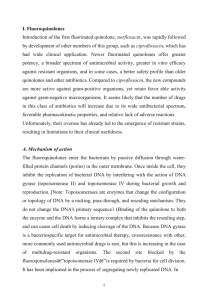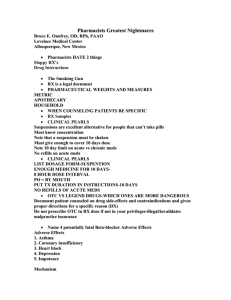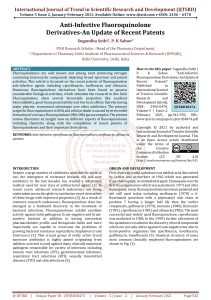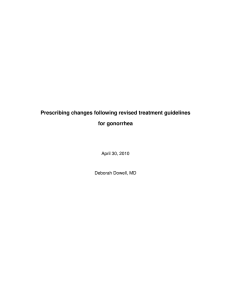magnesium antibiotics
advertisement
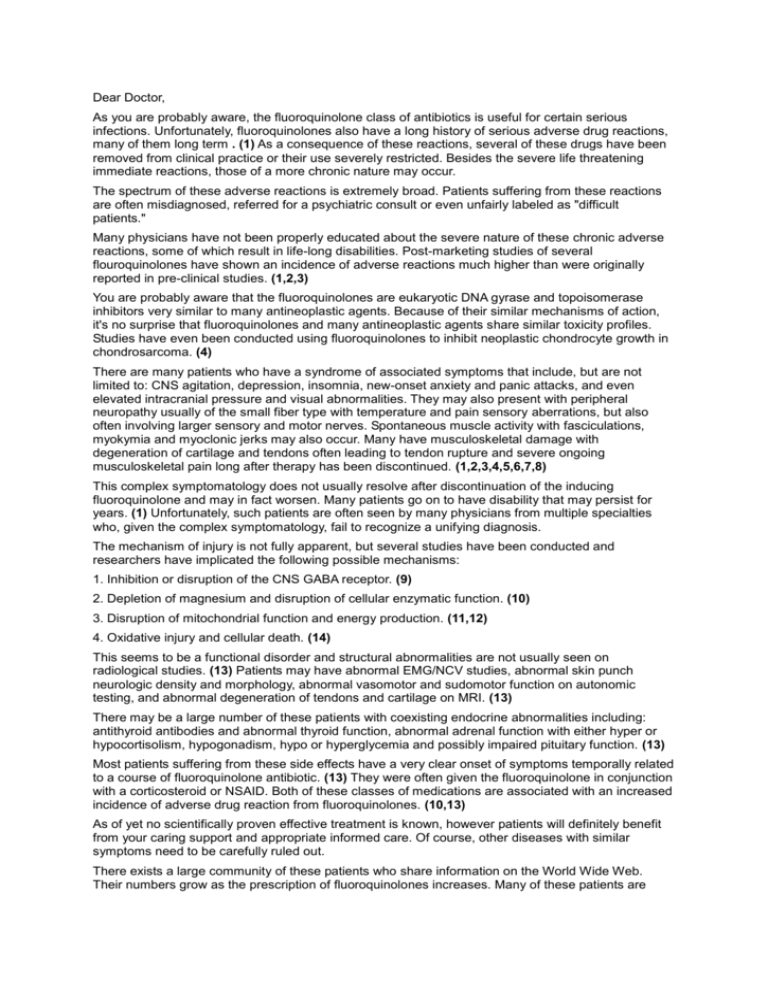
Dear Doctor, As you are probably aware, the fluoroquinolone class of antibiotics is useful for certain serious infections. Unfortunately, fluoroquinolones also have a long history of serious adverse drug reactions, many of them long term . (1) As a consequence of these reactions, several of these drugs have been removed from clinical practice or their use severely restricted. Besides the severe life threatening immediate reactions, those of a more chronic nature may occur. The spectrum of these adverse reactions is extremely broad. Patients suffering from these reactions are often misdiagnosed, referred for a psychiatric consult or even unfairly labeled as "difficult patients." Many physicians have not been properly educated about the severe nature of these chronic adverse reactions, some of which result in life-long disabilities. Post-marketing studies of several flouroquinolones have shown an incidence of adverse reactions much higher than were originally reported in pre-clinical studies. (1,2,3) You are probably aware that the fluoroquinolones are eukaryotic DNA gyrase and topoisomerase inhibitors very similar to many antineoplastic agents. Because of their similar mechanisms of action, it's no surprise that fluoroquinolones and many antineoplastic agents share similar toxicity profiles. Studies have even been conducted using fluoroquinolones to inhibit neoplastic chondrocyte growth in chondrosarcoma. (4) There are many patients who have a syndrome of associated symptoms that include, but are not limited to: CNS agitation, depression, insomnia, new-onset anxiety and panic attacks, and even elevated intracranial pressure and visual abnormalities. They may also present with peripheral neuropathy usually of the small fiber type with temperature and pain sensory aberrations, but also often involving larger sensory and motor nerves. Spontaneous muscle activity with fasciculations, myokymia and myoclonic jerks may also occur. Many have musculoskeletal damage with degeneration of cartilage and tendons often leading to tendon rupture and severe ongoing musculoskeletal pain long after therapy has been discontinued. (1,2,3,4,5,6,7,8) This complex symptomatology does not usually resolve after discontinuation of the inducing fluoroquinolone and may in fact worsen. Many patients go on to have disability that may persist for years. (1) Unfortunately, such patients are often seen by many physicians from multiple specialties who, given the complex symptomatology, fail to recognize a unifying diagnosis. The mechanism of injury is not fully apparent, but several studies have been conducted and researchers have implicated the following possible mechanisms: 1. Inhibition or disruption of the CNS GABA receptor. (9) 2. Depletion of magnesium and disruption of cellular enzymatic function. (10) 3. Disruption of mitochondrial function and energy production. (11,12) 4. Oxidative injury and cellular death. (14) This seems to be a functional disorder and structural abnormalities are not usually seen on radiological studies. (13) Patients may have abnormal EMG/NCV studies, abnormal skin punch neurologic density and morphology, abnormal vasomotor and sudomotor function on autonomic testing, and abnormal degeneration of tendons and cartilage on MRI. (13) There may be a large number of these patients with coexisting endocrine abnormalities including: antithyroid antibodies and abnormal thyroid function, abnormal adrenal function with either hyper or hypocortisolism, hypogonadism, hypo or hyperglycemia and possibly impaired pituitary function. (13) Most patients suffering from these side effects have a very clear onset of symptoms temporally related to a course of fluoroquinolone antibiotic. (13) They were often given the fluoroquinolone in conjunction with a corticosteroid or NSAID. Both of these classes of medications are associated with an increased incidence of adverse drug reaction from fluoroquinolones. (10,13) As of yet no scientifically proven effective treatment is known, however patients will definitely benefit from your caring support and appropriate informed care. Of course, other diseases with similar symptoms need to be carefully ruled out. There exists a large community of these patients who share information on the World Wide Web. Their numbers grow as the prescription of fluoroquinolones increases. Many of these patients are professionals like myself who have been affected by these drugs. Thank you for your time and consideration. Todd R. Plumb MD References: 1. Cohen JS; Peripheral Neuropathy Associated With Fluoroquinolones Annals of Pharmacotherapy. 2001;35(12):1540-1547 2. Francesca Lunzer Kritz; New Cipro, Same Side Effects, Washington Post, December 24, 2002. 3. Shepard CW et al; Antimicrobial Postexposure Prophylaxis for Anthrax: Adverse Events and Adherence Emerging Infectious Diseases ¡E Vol. 8, No. 10, October 2002 4. Fox EJ et al; The effects of ciprofloxacin and paclitaxel on metastatic and recurrent chondrosarcoma COMMUNITY ONCOLOGY ¡½ November/December 2005 5. Physisicans Desk Referfence 2006 6. de Bazignan DA etal; Psychiatric adverse effects of fluoroquinolone: review of cases from the French pharmacologic surveillance database[Article in French] Rev Med Interne. 2006 Jun;27(6):448-52. Epub 2006 Mar 9 7. FDA Medical Bulletin * October 1996 * Volume 26 Number 3 REPORTS OF ADVERSE EVENTS WITH FLUOROQUINOLONES 8. Saint F. etal; Tendinopathy associated with fluoroquinolones: individuals at risk, incriminated physiopathologic mechanisms, therapeutic management [Article in French] Prog Urol. 2001 Dec;11(6):1331-4. 9. De Sano A. etal; Adverse Reactions to Fluoroquinolones. An Overview on Mechanistic Aspects Current Medicinal Chemistry 2001, 8, 371-384 371 10. Stahlmann R. etal; Effects of magnesium deficiency on joint cartilage in immature Beagle dogsimmunohistochemistry, electron microscopy, and mineral concentrations, Archives of Toxicology. Jan. 2000 73(11,12) 11. Hayem G. Cytofluorometric analysis of chondrotoxicity of fluoroquinolone antimicrobial agents. Antimicrob Agents Chemother. 1994 Feb;38(2):243- 7. 12. Kozie[lstrok]; Ciprofloxacin reduces mitochondrial potential and inhibits calcium entry into Jurkat cells R European Journal of Biochemistry 2003; 1 Supplement 1 July: Abstract number: P4.8-33., Zab[lstrok]ocki K., Szczepanowska 13. http://health.groups.yahoo.com/group/quinolones/ 14. Simonin MA etal. Pefloxacin-Induced Achilles Tendon Toxicity in Rodents: Biochemical Changes in Proteoglycan Synthesis and Oxidative Damage to CollagenAntimicrobial Agents and Chemotherapy, April 2000, p. 867-872, Vol. 44, No. 4 Note to readers: The purpose of this E-Letter is solely informational and educational. The information herein should not be considered to be a substitute for the direct medical advice of your doctor, nor is it meant to encourage the diagnosis or treatment of any illness, disease, or other medical problem by laypersons. If you are under a physician's care for any condition, he or she can advise you whether the information in this E-Letter is suitable for you. Readers should not make any changes in drugs, doses, or any other aspects of their medical treatment unless specifically directed to do so by their own doctors.
